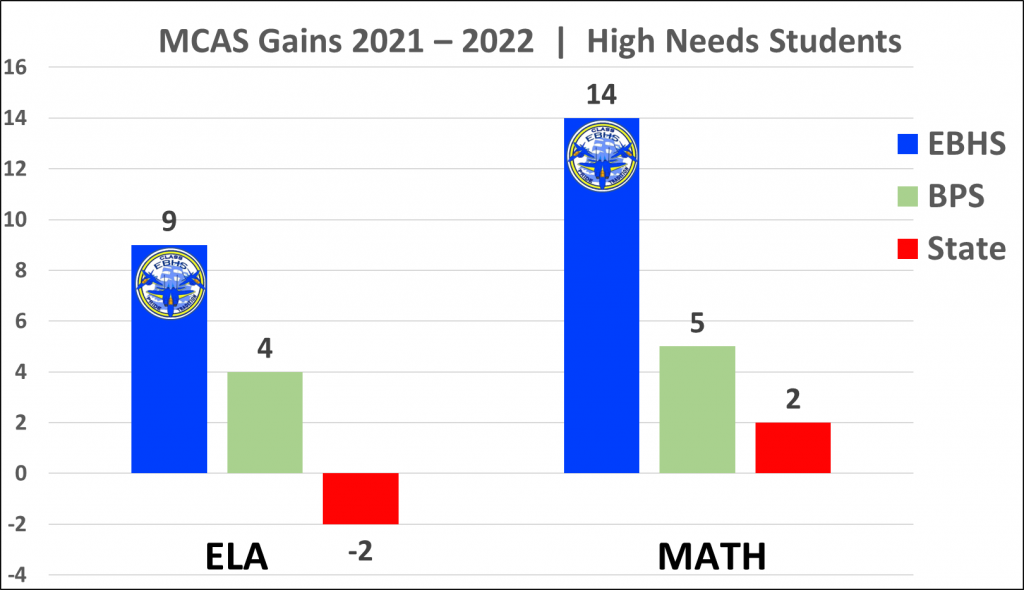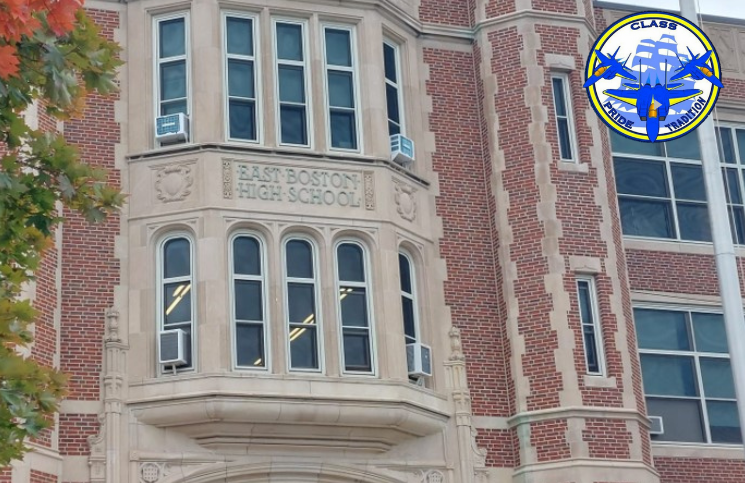by Joan Reissman
The secret sauce of success
In my last post, I referred to the overwhelming volume of data produced by MCAS testing and pledged to dig deeper. Here is my next excavation. We will delve into the performance of East Boston High School (EBHS).
The Boston Public Schools are one district but not all schools operate the same. There are four distinct categories of high school distinguished by their admissions policies. Admission to the three exam schools, a subject of public debate in recent years, is highly competitive and selective, resulting in MCAS scores and other performance measures far above the rest of the district and most of the state. This year, Boston Latin School was the highest scoring school in the state.
Two other categories are less known: selective admission and lottery admission. These six schools have application and qualification procedures that give them a degree of control over the students they admit.
The largest category comprises the 16 open enrollment high schools. These schools welcome any student who wants to enroll. This is the group to which East Boston High belongs.
In the previous post we compared 2022 results to 2021. We noted that Eastie gained 10 points in ELA and 15 points in math while the state declined 6 points and 2 points and the district, the Boston Public Schools including the three high-scoring exam schools and six selective schools, gained 2 points in ELA and 3 points in math.
The comparison to the district is skewed by the inclusion of the exam and selective schools, which play on a different level field. Eastie’s true peer group is the 16 open enrollment schools which have no admission restrictions. In 2022 EBHS led all open enrollment schools in math and tied for first in ELA. In year-to-year gains it was first in math and fourth in ELA.
SUBGROUPS
Our next query concerns subgroups. As previously noted, EBHS hosts a very diverse student body. 75% of students do not have English as their first language, 82% are low income, and 93% are classified as high needs. These percentages exceed the district and the state. The Boston Public Schools are 48% first language not English, 71% low income, and 81.5% high needs. The state’s percentages are 24% first language not English, 44% low-income, and 56% high needs.
EBHS outperformed the district and the state in subgroups. EBHS had 6 subgroups in 2022: students with disabilities, English learners and former English learners, low income, African American, Hispanic/Latino, and white. All of these groups gained from ’21 to ’22 in ELA. Five of the groups gained in math. Most notably, high needs scores and gains were virtually the same as overall scores and gains. The achievement gap was eliminated.
Districtwide, 5 of the 6 groups gained in ELA and all gained in math. Statewide, only 1 group gained in ELA and 3 groups in math. The other groups declined.
In the state’s MCAS reports, low-scoring groups are combined under the umbrella term “high needs.” This bar graph compares the gains of East Boston’s high needs students, in terms of percent meeting or exceeding expectations, with the gains (or losses) of the BPS district as a whole and of the state.

HOW DO THEY DO IT?
After we’ve admired EBHS’s comparative performance and subgroup equity, the next question is: How do they do it?
JFYNetWorks has been working with East Boston High since 2015. The program has grown every year. All 9th and 10th grade students are enrolled in both ELA and math programs. Students work in their JFYNet curriculum for 40 minutes twice each week– 80 minutes of ELA and 80 minutes of math per week, on top of their regular classes. JFY supports EL classes and 11th and 12th grade ELA and math classes. The 11th and 12th graders may also take the College Board Accuplacer tests, which assess college-level skills and which JFY administers. We cannot say enough about the hard work and dedication of teachers, administrative staff and students. Their implementation of the JFYNet program is the secret sauce of success.
Educators everywhere are worried about getting students back to pre-pandemic levels. East Boston High shows that dedicated staff, focused intervention, and hard work can make the critical difference.
Once again, the volume of data and information has overwhelmed your hard-working reporter. I will have to return to this question—how do they do it?—in my next post.
Please stay tuned.
Joan Reissman, the MCAS Maven, is a JFYNetWorks learning specialist.
Image source: Facebook EBHS page, https://www.facebook.com/photo/?fbid=588233949764469&set=a.310724730848727
Other posts authored by Joan can be found here.
HOW ARE WE DOING? In our pursuit to serve up content that matters to you, we ask that you take a couple of minutes to let us know how we’re doing? Please click here to be navigated to our JFYNet Satisfaction Survey. Thank you!





